The Gift of South Dakota
Subscriptions to South Dakota Magazine make great gifts!
Subscribe today — 1 year (6 issues) is just $29!
Art-Warming
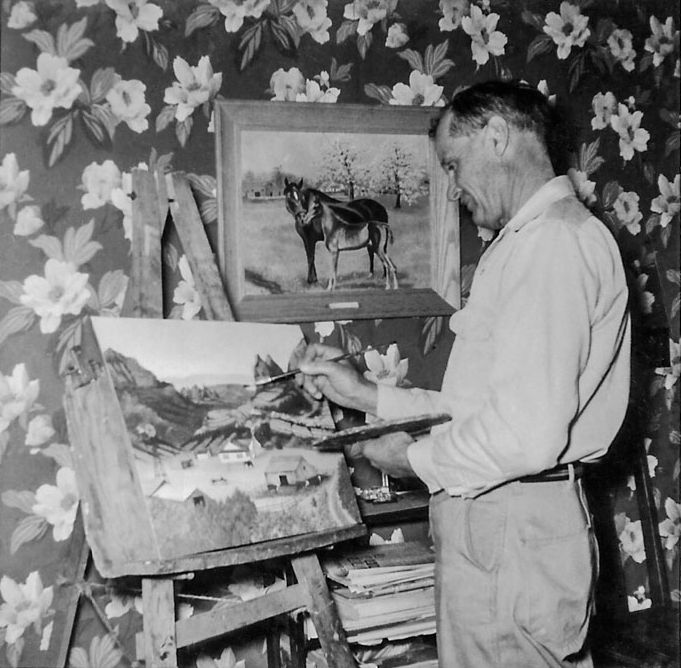 |
| The grandchildren of Fred Mohling, pictured painting in his Aurora County farmhouse in 1957, are rediscovering his artwork and are exploring ways to share it with South Dakotans. |
In 1959 Aurora County farmer Fred Mohling traveled to California for the Rose Bowl. Naturally, when he returned to South Dakota, friends and family asked about the game.
Mohling couldn’t tell them much. He hadn’t gone to watch football, he explained, but to see the roses in the famous parade. At home, in addition to selling grain and cattle, Mohling created paintings, including still lifes with flowers. Today, 40 years after his death, his descendants are sorting through his works: Midwestern and Western landscapes, people, waterfowl, horses, hunting dogs and still lifes. The family doesn’t necessarily want to sell the art but would like to exhibit some of it, maybe at libraries as a starting point. The learning curve is steep, exploring exhibition protocol, likely venues, copyright and even framing (when Mohling framed his art he sometimes purchased cheap and rather gaudy hardware store frames).
There’s another holiday season story about Mohling. Seventy years ago this December he skillfully painted a life-sized Christmas Nativity scene and other holiday images on plywood and illuminated them with 100 white and colored lights for his grandchildren. He set it up on his farm, just south of the Aurora-Jerauld County line, where it delighted more than his grandkids. As word spread, hundreds of South Dakotans drove 75 miles or more, on two-lane roads in winter, to see the scene. Memories of the Nativity art are mostly all that remain. The painted figures largely disappeared. Mohling’s farmhouse and ag buildings were razed for corporate farming, and the farmer-artist himself died in 1984.
 |
| Harmony Friends Church |
His painting of a mountain scene is part of the Center for Western Studies collection at Augustana University in Sioux Falls, and another found a home in the Wessington Springs museum. But most were divided among family. “There are more than we remembered seeing around his house years ago,” says grandson John Swanson of Rapid City. He believes his grandfather completed more than 150 paintings, usually ranging from 8-by-10 inches to 16-by-20 inches in size. Another grandson, Greg Miller, notes that Mohling mostly used oils on board surfaces, and also drew with charcoal as well as colored pencils late in life. “There was something about winter scenes,” Miller says. “He looked at snow much of the year and liked it.” Miller has taken a lead role in documenting Mohling’s life through newspaper clippings and public records.
Great-grandson Ryan Aalbu of Spearfish was young when Mohling died and only vaguely remembers the man, but he treasures his paintings. “Mine are outdoor scenery and animals,” Aalbu says. “I didn’t know until fairly recently that he was a good portrait artist, too, painting people from American presidents to his own family.”
Fredrick Henry Mohling, born in 1894, grew up as the eldest of eight children on a Nebraska farm. At home he spoke German but made the mental switch to English for school. A capable student, Mohling hurried through his in-school lessons so he could draw at the end of classes, and at age 12 he won first prize for a painting he took to an Old Settlers picnic.
He married Tillie Maschman, and they had seven children, which left little time for art. The Mohlings moved to South Dakota to farm in 1920 and weathered bad ag prices that decade and the Dust Bowl and Depression of the 1930s.
The hard times led to President Franklin Roosevelt’s Works Progress Administration. Gov. Tom Berry insisted that art be part of the WPA and Mohling renewed his interest in painting by taking three classes in Mitchell. He was also inspired by a landscape artist he saw at the State Fair.
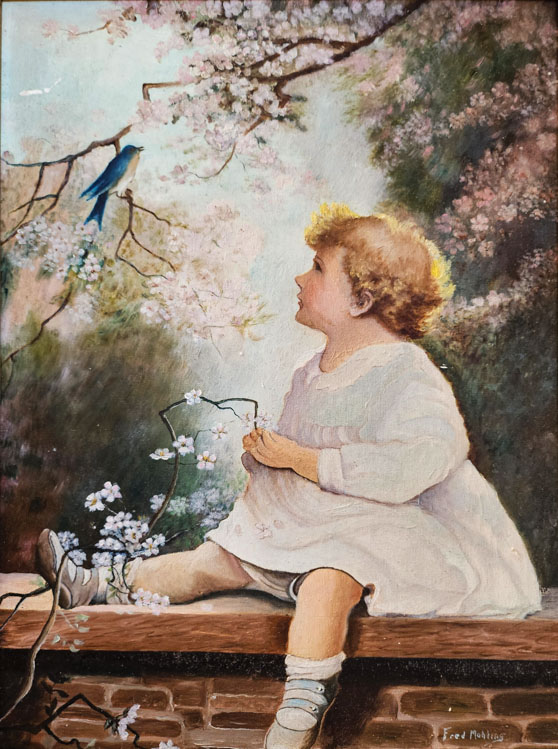 |
| Blue Jay Wonder |
Sadly, his family thinks that Mohling’s main motivation to paint was his deep grief after Tillie died suddenly from an appendix ailment in 1940. Art became his therapy, perhaps, or at least a way to occupy his mind. “When you do something requiring great attention to detail, you can’t think about other things,” Swanson says. A family member recalled coming home from a dance to find Mohling working at his easel in the middle of the night.
Still, Mohling didn’t hit his stride with art, in terms of quality and output, for a few years. There was always work on the farm. He also landscaped his big yard, created a lily pond and outdoor fireplace, and he built swings for his kids and grandkids. When Tillie died, two of his children were young adults who helped to raise the younger five. Mohling enjoyed traveling by car with his family and drove them to the Black Hills to see Josef Meier’s Passion Play, a religious drama performed in Spearfish on what was billed as the world’s “longest outdoor stage,” all of it skillfully lighted. Maybe the biblical production was the inspiration for Mohling’s own outdoor Christmas presentation.
“That could be,” Swanson says. “He liked visuals, obviously, and things built big. He drove to Texas once to see the new Houston Astrodome, which was called the eighth wonder of the world.” The family has no record as to whether Mohling saw a ballgame during that trip or simply admired the big domed stadium.
Swanson describes his grandfather as a type of man most South Dakotans might know. He was accomplished in agriculture, could build anything, and — far from the stereotype some Americans held of rural Midwesterners in that time — wasn’t cocooned in his own locality but interested in the wider world.
Mohling took enough interest in his 20 grandchildren to buy or make each a meaningful gift every Christmas, granddaughter Jane Aalbu remembers. His gifts would only get better: one of his original paintings for high school graduation and another as a wedding present if a grandchild got married.
“He was mild-mannered and soft-spoken, and fairly easy to talk to,” says Swanson, who was in his 20s when Mohling died. The farmer-artist didn’t drink except for perhaps a glass of Mogen David wine on holidays. Knowing his distaste for alcohol, his descendants have had light-hearted discussions about whether it would be appropriate to serve higher quality wines at exhibits of his art.
Through years of raising children, bonding with grandchildren, and adapting to post-World War II ag technologies, Mohling kept improving his art techniques. Swanson recalls seeing the classic Blue Boy (a portrait by 18th century English artist Thomas Gainsborough) among his grandfather’s possessions and assumed Mohling admired it and bought a print. As it turned out, Mohling copied it stroke by stroke — a time-honored method that artists have used to fine-tune their skills.
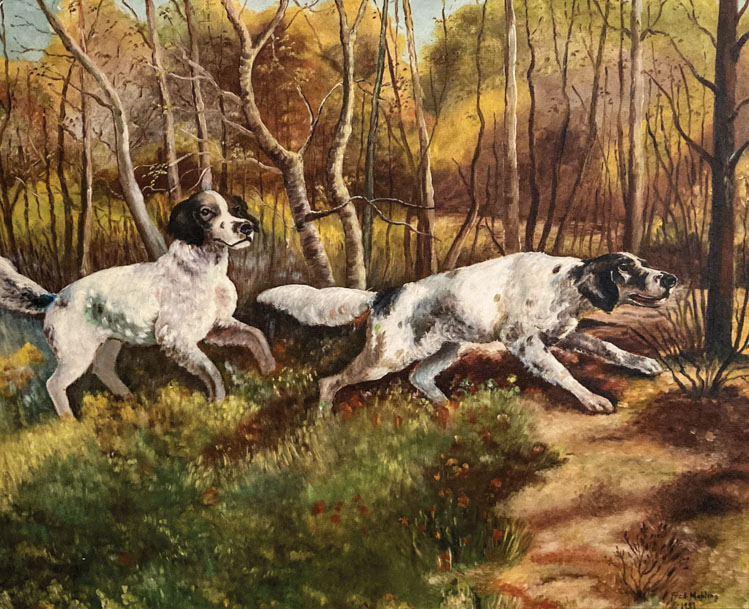 |
| Buckeye Brown |
Mohling didn’t seem interested in selling his works but in 1955 Wessington Springs hosted a horse show. Mohling loaned horse paintings to Rukstadt Hardware Store for a window display during the event. An Indiana man admired a threshing scene and Mohling agreed to sell it to him. In 1956 he won two blue ribbons at the State Fair; he’d previously taken home art ribbons from Huron but never before a first-place honor, let alone two. Those blue-ribbon paintings almost certainly remain in the family’s possession, and they hope to determine which they are.
In the late 1950s and beyond, Mohling took his art to appreciative rural audiences in Clark, Faulkton, Wessington Springs, Mitchell and Fairbury, Nebraska, near his birthplace. Plankinton journalist Adeline VanGenderen reported on a show where a woman rhetorically asked how anyone could choose a Mohling favorite given the wide variety of scenes and subjects. “We got to thinking this over, and how could you?” VanGenderen wrote. “First your eye would be drawn to a moose beside the lake; deer drinking from the stream; an Indian pony and its rider; you could almost smell the dust of the covered wagon as it groaned westward.”
If art scholars had read VanGenderen’s description, they might have concluded that Mohling was part of the Regionalism art movement, especially popular in the rural Midwest in the mid-20th century and best epitomized by Iowa painter Grant Wood. The style became popular nationally as Americans first feared that the Midwest was being blown off the map by Dust Bowl winds, and then again as they celebrated that it wasn’t.
But there’s no evidence Mohling saw his art as part of any movement or school of thought. South Dakotans tend to be skeptical of those who categorize local visual art as Fine, Folk, Regionalism or any other grouping. Most would agree with the late University of South Dakota professor and author Graham Thatcher, who warned against associating with any “sophisticated art nerd who asks you what you think in order to get an opening for his or her well-rehearsed sermonette.” Thatcher stressed, in his book I Know What I Like! Everyone’s Guide to the Arts, “There are no rules in Art … there is only taste.”
Mohling met the tastes of South Dakotans half a century ago. In 1974, friends and family turned out in force for his 80th birthday celebration in a Wessington Springs ag building, its interior walls decorated for the day with 80 pieces of his art.
Today, Mohling’s descendants are working to determine whether 21st century South Dakotans find significance in the art, as well. In August the family put digitized images on a video loop and played it at Mitchell’s Corn Palace Festival. They may do the same at the State Fair next year. A professor has suggested the paintings may hold value for students learning about both the techniques Mohling used and the times in which his art took form.
Relatives don’t anticipate a posthumous discovery of Mohling’s talent beyond the borders of South Dakota. They’ll be happy if small groups of observers see something in his art that warms their hearts.
That’s what art did for Fred Mohling, and it was quite enough.
Editor’s Note: This story is revised from the November/December 2024 issue of South Dakota Magazine. To order a copy or to subscribe, call (800) 456-5117.

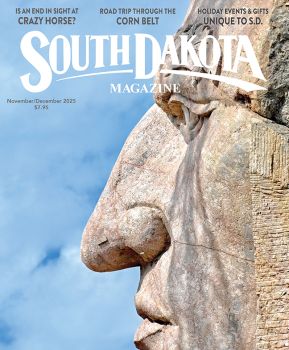


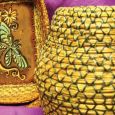


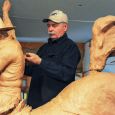
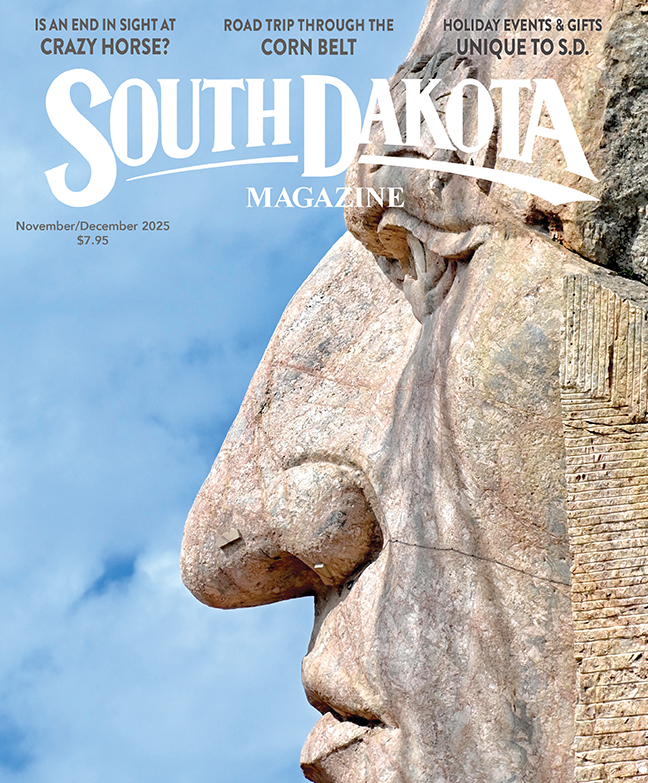
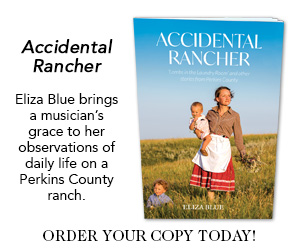
Comments
Thanks, J Uzzell
Thanks, J Uzzell